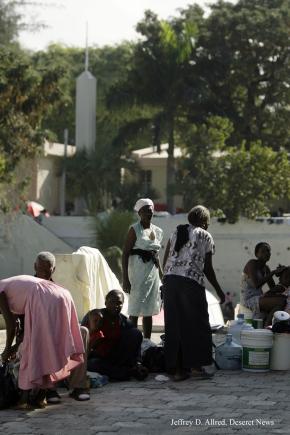Difference between revisions of "Template:Humanitarian Aid Updates"
| Line 1: | Line 1: | ||
| − | ''' | + | '''Latter-day Saints Continue to Help in Haiti''' |
| − | + | [[Image:Haiti_JDA_0058.1.jpg|left|frame|Haitians gather outside an LDS Chapel in Haiti]] | |
| − | [[Image: | + | Immediately after the earthquake in Haiti, [[The Church of Jesus Christ of Latter-day Saints]] began to mobilize to send help. The [[Mormon Church]] sent 85,000 pounds of supplies from Miami. That shipment included emergency resources such as food, blankets, tents and tarps. Other shipments of food and supplies followed, with [[Mormon Missionaries|LDS missionaries]] serving in Haiti helping to move supplies and acting as translators for aid workers. Men who have formerly served missions in Haiti flew over to help, knowing their skills in Creole and French would be needed. Branch and [[ward]] meetinghouses and grounds were opened to receive refugees. Temporary shelters were sent over from the United States, and medical personnel were sent. By late February, 2010, the Mormon Church had donated $4.25 million worth of relief. |
| − | |||
| − | |||
| − | + | Now, one year after the devastating event occurred, and after the Church also sent aid to help during the ensuing cholera outbreak, Latter-day Saints continue to provide aid. In addition to aid delivered formally by the Church, funded by donations of members of the Church, Latter-day Saint entrepreneurs are taking it upon themselves to help. One project, called "Sustain Haiti," is the result of a careful analysis of the stages of aid needed after such a disaster. After the stages of rescue, relief, and recovery, comes rebuilding, and many relief organizations are long-gone when that stage looms ahead. The group "identified key tasks and formed teams around those tasks: a needs assessment of the Haiti situation, logistics for how to get people to Haiti, fund-raising, recruiting of volunteers, Haitian culture and Creole language lessons, where to labor in Haiti, and what skills [they] could offer the survivors. [They] drew on the definition of Mormon charity described by President [[Joseph F. Smith]]. [Their] underlying values centered on putting the people in such a way as they may be able to help themselves." [http://www.meridianmagazine.com/lds-church-updates/1/7104/article] | |
| + | |||
| + | Focusing on bringing in non-denominational volunteers, the group centered on a multi-faceted process of rebuilding, including educating the people to grow home-grown produce to use and to sell; providing sanitation and hygiene; providing clean-water technology; and creating methods for people to generate income. | ||
| − | + | For some projects, the leaders of Sustain Haiti train local, Haitian Latter-day Saints, who can then train others, thus spreading skills among the population. | |
| − | + | ||
| − | Donations for relief efforts can be made at [http://give.lds.org/emergencyresponse LDS Emergency Response]. | + | Donations for LDS Church relief efforts can be made at [http://give.lds.org/emergencyresponse LDS Emergency Response]. |
Revision as of 13:08, 28 December 2010
Latter-day Saints Continue to Help in Haiti
Immediately after the earthquake in Haiti, The Church of Jesus Christ of Latter-day Saints began to mobilize to send help. The Mormon Church sent 85,000 pounds of supplies from Miami. That shipment included emergency resources such as food, blankets, tents and tarps. Other shipments of food and supplies followed, with LDS missionaries serving in Haiti helping to move supplies and acting as translators for aid workers. Men who have formerly served missions in Haiti flew over to help, knowing their skills in Creole and French would be needed. Branch and ward meetinghouses and grounds were opened to receive refugees. Temporary shelters were sent over from the United States, and medical personnel were sent. By late February, 2010, the Mormon Church had donated $4.25 million worth of relief.
Now, one year after the devastating event occurred, and after the Church also sent aid to help during the ensuing cholera outbreak, Latter-day Saints continue to provide aid. In addition to aid delivered formally by the Church, funded by donations of members of the Church, Latter-day Saint entrepreneurs are taking it upon themselves to help. One project, called "Sustain Haiti," is the result of a careful analysis of the stages of aid needed after such a disaster. After the stages of rescue, relief, and recovery, comes rebuilding, and many relief organizations are long-gone when that stage looms ahead. The group "identified key tasks and formed teams around those tasks: a needs assessment of the Haiti situation, logistics for how to get people to Haiti, fund-raising, recruiting of volunteers, Haitian culture and Creole language lessons, where to labor in Haiti, and what skills [they] could offer the survivors. [They] drew on the definition of Mormon charity described by President Joseph F. Smith. [Their] underlying values centered on putting the people in such a way as they may be able to help themselves." [1]
Focusing on bringing in non-denominational volunteers, the group centered on a multi-faceted process of rebuilding, including educating the people to grow home-grown produce to use and to sell; providing sanitation and hygiene; providing clean-water technology; and creating methods for people to generate income.
For some projects, the leaders of Sustain Haiti train local, Haitian Latter-day Saints, who can then train others, thus spreading skills among the population.
Donations for LDS Church relief efforts can be made at LDS Emergency Response.
